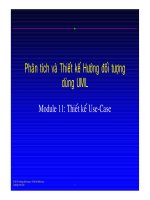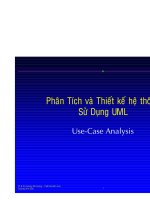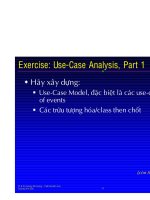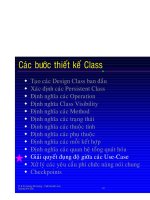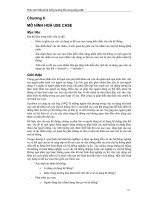ICONIX process use case driven objec modeling
Bạn đang xem bản rút gọn của tài liệu. Xem và tải ngay bản đầy đủ của tài liệu tại đây (2.36 MB, 126 trang )
ICONIX Process:
Use Case Driven Object Modeling
Copyright 2007 ICONIX Software Engineering, Inc.
1
The goal. Driving a good O-O
software design from use cases.
Copyright 2007 ICONIX Software Engineering, Inc.
2
ICONIX Process:
Use Case Driven Object Modeling
•
•
•
•
•
Introduction
The 10,000 foot view
ICONIX Process Roadmap
The 1000 foot view
Summary
Copyright 2007 ICONIX Software Engineering, Inc.
3
Introduction
• The difference between Theory and Practice
• Disambiguation – the key to use case driven
development
• Getting from use cases to code
• The ICONIX UML core subset
Copyright 2007 ICONIX Software Engineering, Inc.
4
The difference between Theory
and Practice…
• In theory, there is no difference between
theory and practice. In practice there is.
• In practice, UML is TOO BIG.
• In practice, there’s never enough time for
modeling.
• ICONIX Process is a streamlined approach
that helps you get from use cases to code
quickly, using a UML core subset.
Copyright 2007 ICONIX Software Engineering, Inc.
5
Disambiguation…the key to use case
driven development
In theory, abstract use cases are good. In
practice, they’re vague and ambiguous.
Copyright 2007 ICONIX Software Engineering, Inc.
6
Key features of ICONIX Process
• Avoids analysis paralysis
• Core subset streamlines use of UML
• High degree of traceability
Copyright 2007 ICONIX Software Engineering, Inc.
7
We’d like to get from Point A to
Point B, as quickly as possible
Copyright 2007 ICONIX Software Engineering, Inc.
8
Defining a UML core subset
• The ICONIX Core Subset helps us to avoid
analysis paralysis.
• We’ll work backwards from code to
determine which parts of the UML we really
need.
• Then we’ll leave everything else out.
• But feel free to use any other UML diagrams
that you might have a specific need for.
• Less is more. 4 diagrams are better than 14.
Copyright 2007 ICONIX Software Engineering, Inc.
9
Working backwards from code
Let’s assume that we’ve done a little prototyping, and
started to write some use cases.
But code is our desired destination.
Copyright 2007 ICONIX Software Engineering, Inc.
10
OOAD, oversimplified
• 2 fundamental questions.
• OBJECT DISCOVERY: What are all the
objects?
• BEHAVIOR ALLOCATION: How are the
functions mapped across the objects?
• When we know what classes we need, what
the software functions are, and have mapped
the functions onto the classes, we’re a long
way towards understanding the design.
Copyright 2007 ICONIX Software Engineering, Inc.
11
Before we get to code, though...
We need a complete set of classes, with
accompanying attributes and methods.
We show this information on design-level class
diagrams.
Copyright 2007 ICONIX Software Engineering, Inc.
12
Design-Level Class Diagrams
Our design-level class diagrams define the structure of
our code.
Copyright 2007 ICONIX Software Engineering, Inc.
13
Before we have classes with
attributes and methods, though...
BEHAVIOR ALLOCATION:
We make decisions about which classes are
responsible for which methods while we are
drawing sequence diagrams.
So, we need to draw a sequence diagram for
each use case.
Copyright 2007 ICONIX Software Engineering, Inc.
14
Sequence Diagrams
We allocate methods to classes as we draw sequence
diagrams.
Copyright 2007 ICONIX Software Engineering, Inc.
15
Before we do sequence diagrams,
though...
We need unambiguous use case text.
We need to have a good idea about which
objects will be participating in each use case,
and what functions the system will perform as a
result of user actions.
We identify participating objects, and the
software functions that we need for a use case,
during robustness analysis.
Copyright 2007 ICONIX Software Engineering, Inc.
16
Robustness Diagrams
OBJECT DISCOVERY: We discover new objects,
identify functions, and add attributes to classes, as we
draw robustness diagrams. We also disambiguate the
use cases.
Copyright 2007 ICONIX Software Engineering, Inc.
17
Abstract, technology-free use cases
are vague, ambiguous, incomplete
Copyright 2007 ICONIX Software Engineering, Inc.
18
Robustness diagrams help us
disambiguate the use cases
DISAMBIGUATION: We describe system usage in the
context of the object model.
This means that we don’t write abstract, vague,
ambiguous use cases that we can’t design from.
Instead, we need to write use case text that references
the names of objects in the problem domain.
We also reference the names of "boundary
objects“ (screens) explicitly in the use case text.
Copyright 2007 ICONIX Software Engineering, Inc.
19
First, though...
We need to identify the main abstractions that
are present in the problem domain.
In other words, we need a domain model.
We show our domain model on class diagrams.
Copyright 2007 ICONIX Software Engineering, Inc.
20
Domain Model
Copyright 2007 ICONIX Software Engineering, Inc.
21
Refining our class diagrams
We'll continuously refine our analysis level class
diagrams (our domain model) as we explore the
behavior of the system in more and more detail
during analysis and design.
This will ultimately result in our design-level
class diagrams, which we can code from.
Copyright 2007 ICONIX Software Engineering, Inc.
22
The ICONIX UML Core Subset
Copyright 2007 ICONIX Software Engineering, Inc.
23
Break
• Good news: we don’t have to cover the
other 10 UML diagram types (state diagrams,
activity diagrams, communication diagrams,
component diagrams, deployment diagrams,
timing diagrams….) before break
• Better news: we don’t have to cover them
after break, either
Copyright 2007 ICONIX Software Engineering, Inc.
24
The 10,000 foot view
• Each diagram answers a question.
• Use Cases: What are the users doing?
• Domain Models: What are the objects in the real
world?
• Robustness Diagrams: What objects participate
in each use case?
• Sequence Diagrams: How do the objects
collaborate with each other?
Copyright 2007 ICONIX Software Engineering, Inc.
25

